'Cabbage Patch' Line
The Choshi Dentetsu in Eastern Chiba Prefecture
By Colin Brown
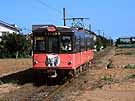
Rolling down on the poorly ballasted track mixed with weed and soil is car 1001, the most recently introduced stock.
By Brian Walker, in August 2000.
|
Prologue:
'Cabbage Patch' Line is the 'nickname' I applied to the Choshi Dentetsu
(Choshi Electric Railway). The reason is because it passes through an
area which closely resembles the district to the north-east of my home
near Biggleswade. It is famous for the cultivation of the best green
vegetables in the UK. Following on from the spring 2000 JRS Railtour
our Chairman and myself stayed for a further week. We had the use of
his son's flat at Ichinowari, one stop south of Kasukabe on the Isesaki
line of the Tobu Railway. In fact we commuted by Shinkansen from Tokyo
most evenings via Omiya on our JR Railpass. This avoided the need to
reach the Asakusa terminus and also the requirement to pay the full
fare on the Tobu. Sometimes we even got a complimentary cup of coffee!
Situation:
Located on a hammer-head shaped headland on the large peninsula which
is Chiba Prefecture, Choshi is the most easterly point of the
prefecture. It is situated on the Tonekawa, the boundary between Chiba
and Ibaraki Prefectures and faces the Pacific Ocean. Close to the city
which is one of the largest fishing ports in Japan is the Iinuma Temple
and Choshi Port Tower at the Suisan Port Center, from which can be had
a fine view of the mouth of the river and the Port. The Port Festival (Minato Matsuri)
is held every August and needless to say the area is important for its
many seafood restaurants. In the town are craft workshops which make
traditional 'maiwai' fishermen's festive costumes as well as the 'tairyobata'
hand painted cotton fishing banners. Apart from shoyu (soya sauce)
breweries there is a flourishing industry in the production of bamboo
ware, paper umbrellas (sunshades), hand painted paper kites and
miniature fishing boats in the traditional style. Probably the most
famous items are the 'boshu uchiwa' flat decorated fans.
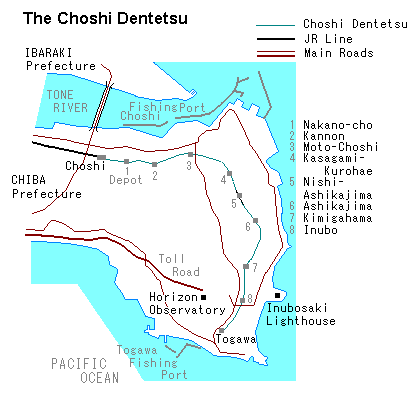 Access:
Access:
Choshi can be accessed from the north by the JR Narita line via Sawara
after a journey of 85 minutes. A slightly longer trip of about 90
minutes eastwards by class 183 EMU on the Sobu line from Chiba via
Sakura is possible. Just before entering Choshi there is a substantial
rail-served warehouse and many sidings, reflecting no doubt the storage
and distribution of the local land and sea produce.
Background:
Originally a steam line, which only lasted for four years from 1912,
served the scenic headland. In 1923 petrol driven locomotives started
working a new 6.4 km long 1,067 mm gauge line which was soon
electrified with overhead power supply in 1925. The railway jogged
along unspectacularly until taken over by the local bus company in
1963, thereby saving the line from the threat of closure.
Ticket Office:
Walking through arches of a stylized windmill, trains leave from a bay
platform at the east end of the JR station. Alongside this can be seen
the running depot where blue and cream JR class 113 EMUs of the Narita
Line layover. One stop on the short 10 station line at Nakano-cho is
the depot, squeezed in between the buildings of a soya sauce brewery.
It was here that we discovered the railway's side line of packing 'bento'
boxes as well as other items for various clients. In fact the tiny
booking office was submerged in cardboard boxes which overflowed onto
the narrow platform. There was also a small sales outlet where Richard
bought a canned Tuna Curry, although I think he passed it on to his
son. Above the 12" square ticket office grille was the only item of
English, which said 'to sell tickets' in handwriting. Higher up was a
complete fare table hand written in chalk on a blackboard and dated 1
July 1997, in Japanese style, (9-7-1) it listed single fares as well as
one, three and six monthly fares for both adults and children. However
there are fare tables of the 'stepped' variety (as we used to see
displayed on London buses) above a 'J' shaped map of this line on the
cars. The 'J' shape lies on its side, ie. - as the line starts off
eastwards and then turns south to its coastal terminus. The full cost
for an adult single trip is 310 Yen with the child fare at half but
adjusted slightly upwards to the nearest 10 Yen, eg. 160 Yen for the
full run. There is an attractive colourful single fold 160 x 87 mm
'Komawari Tegata Oneday Open Ticket' at 620 Yen (310 Yen child). Not
only does it have 5 tear-off strips and a map of the headland and the
line with local places of interest indicated, on the rear, it carries a
nice picture of car #701, amidst green vegetables with the lighthouse
on the cliff and the sea on the horizon. The full date was hand written
by the booking clerk and my copy also has the traditional rubber date
stamp. The inside carries a large proportion of Japanese script (for
such a small railway) plus a vertical diagram with each station
indicated and the time taken between each one. With the longest being 3
minutes and the shortest 1 minute, the total journey time iis seen to
be 16 minutes, giving an average speed of 22.5 km/h (14 mph).
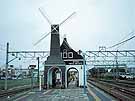
Walking through arches of a stylized windmill, trains leave
from a bay platform at the east end of the JR station. Alongside this
can be seen the running depot where blue and cream JR class 113 EMUs of
the Narita Line layover.
By Colin Brawn, in April 2000.
|

The ticket office of Nakano-cho station is in an about 12"
square room. Higher up the grille is a complete fare table hand written
in chalk on a blackboard and dated 1 July 1997.
By Colin Brawn, in April 2000.
|

There are fare tables of the 'stepped' variety above a 'J' shaped map of the line on the cars.
By Colin Brawn, in April 2000.
|
Service:
Although as might be expected there is a passing loop and sidings at
the depot, the loop was occupied by what was presumably the peak
service 2-car EMU on layover. During the off peak, service is
maintained by two single cars passing at Kasagami-Kurohae, where
derelict car #101, with heavily peeling paintwork was stored on a
siding. Track in the depot area was reasonable with timber sleepers on
rather shallow ballast. Progressing toward the coastal terminus at
Togawa with its single car stub end and loop, there was more weed and
the ballast was mixed with soil. The penultimate station of Inubo
(Inuboh) has an impressive arch which is inscribed with a shield
carrying the wording Inuboh Estacao
(Spanish maybe?). This is the place to detrain for the 1 km walk
eastwards to the old Inubosaki Lighthouse on Cape Inubosaki. About the
same distance in the opposite direction is the
Chikyu-no-Maruku-Mieru-Oka-Tembokan, which is a Horizon Observatory
from which there is a total 360° panoramic view of the headland.
From the viewpoint the 50 meter high cliffs facing the Pacific can also
be seen. Further south-west along the coast is one of the finest white
sand beaches stretching for 60 km to Misaki-machi, backed by
restaurants, pensions and hotels and a seaside park with 27 tennis
courts and 13 pools. In fact everything one could want for holidaying.
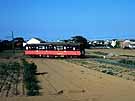
Most parts of the line run through sandy landscapes surrounded with vegetables fields.
By Brian Walker, in August 2000.
|
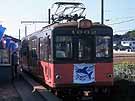
Type 1000, Deha 1001 and 1002, used to be subway cars of the
Eidan Subway Ginza Line. After receiving refurbishment, they came to
this line in 1994. They are high-performance cars equipped with four 75
kw traction motors.
By Brian Walker, in August 2000.
|
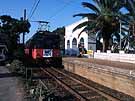
The penultimate station of Inubo (Inuboh) has an impressive arch which is inscribed with a shield carrying the wording Inuboh.
By Brian Walker, in August 2000.
|
Crew and Rolling Stock:
Crew uniforms consist of bright yellow jackets and a yellow company tie
with dark trousers, topped by a yellow 'pill-box' cap with a black
peak. However the car liveries are an attractive but slightly garish
salmon-pink on the lower panels with a rich dark brown window band and
a yellow cant rail line. Car numbers are yellow and placed in the
centre of the front below the large pink painted headlights on the
roof. Car numbers are also carried low down at the trailing end, ie.
away from the pantograph, on the gold lined-out lower panels, which
show the company name. The six passenger cars are numbered 301, 701/2,
801 and 1001/2. All have different body styles, being as they are
second-hand from various other lines. Number 301 has 3 passenger doors
per side. #701/2 have 2 front windows, a side driver's door and 2
passenger doors per side, and were acquired in 1978. Car 801 was
acquired in 1986, has a center front door, 3 passenger doors per side
and a side driver's door. Cars 1001/2 were refurbished by and acquired
from the Eidan Subway in 1994. They also have center front doors, 3
side passenger doors and a driver's side door.
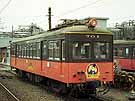
Type 700, Deha 701 and 702, are 1941 made old EMUs came from
Omi Railway in Shiga prefecture. They were transferred to this line in
1978. They have different front styles at both ends. Two-window style
is at the Choshi end.
By Colin Brawn, in April 2000.
|
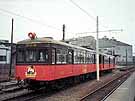
The type 700's Togawa end is in 3-window style.
By Colin Brawn, in April 2000.
|
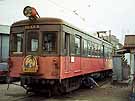
1950 made Deha 801 was acquired from the Iyo Railway in
Shikoku in 1986. This type is still one of the main stock in the Choshi
Dentetsu fleet along with type 700 and 1000.
By Colin Brawn, in April 2000.
|
4-wheel steeple cab loco:
One of the most unusual items of rolling stock is a black painted,
rather peeling, 4-wheel short wheelbase steeple cab loco with a bow
collector. This is lettered CDK (most probably Choshi Dentetsu Kabushikigaisha
- Choshi Electric Railway & Co. Ltd.) on the side at one end and
AEG (Allgemeine Elektrizitaes Gesellschaft, the German builder) and #3
at the opposite end. There is also a strange 4-wheel opensided tourist
carriage which appears to have been built on a wagon underframe.
Numbered 101 (a duplicate) it also carries the initials CDK and has a
roof supported by 8 pillars. It sports a vertical brake shaft with a
horizontal yellow painted handwheel. In a seaside 'fun' way it is
painted light blue with dark blue stylized waves topped with white,
along the lower sides. It was presumably pulled by the steeple cab loco
which was built in 1922 but not acquired until 1941. Signalling on the
line is 2 aspect colour light.
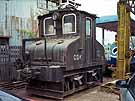
4-wheel short wheelbase steeple cab loco Deki 3 with a bow
collector. This locomotive was made in 1922 by AEG in Germany and came
to this line in 1941. Its motive power is two sets of 29.8 kw traction
motors. This vintage loco is still maintained in working order.
By Colin Brawn, in April 2000.
|
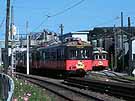
A view of Nakano-cho depot squeezed in between the buildings of a soya sauce brewery.
By Brian Walker, in August 2000.
|
|
Epilog:
The whole of this short railway carries the ambience of a fun seaside tourist line serving an area of coastal scenic beauty!
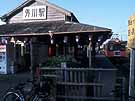
Togawa station retains a good old days ambience with a wooden station building.
By Brian Walker, in August 2000.
|
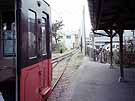
The line ends at a pinched loop with a spring point connecting to a siding.
By Colin Brawn, in April 2000.
|
|
[Home Page]


 Access:
Access: